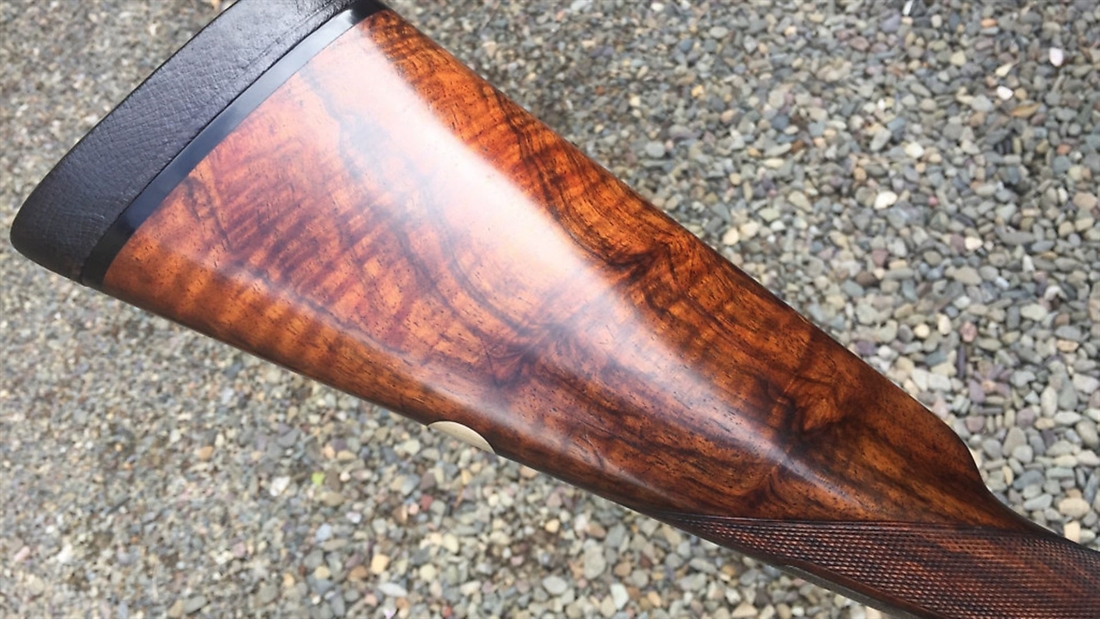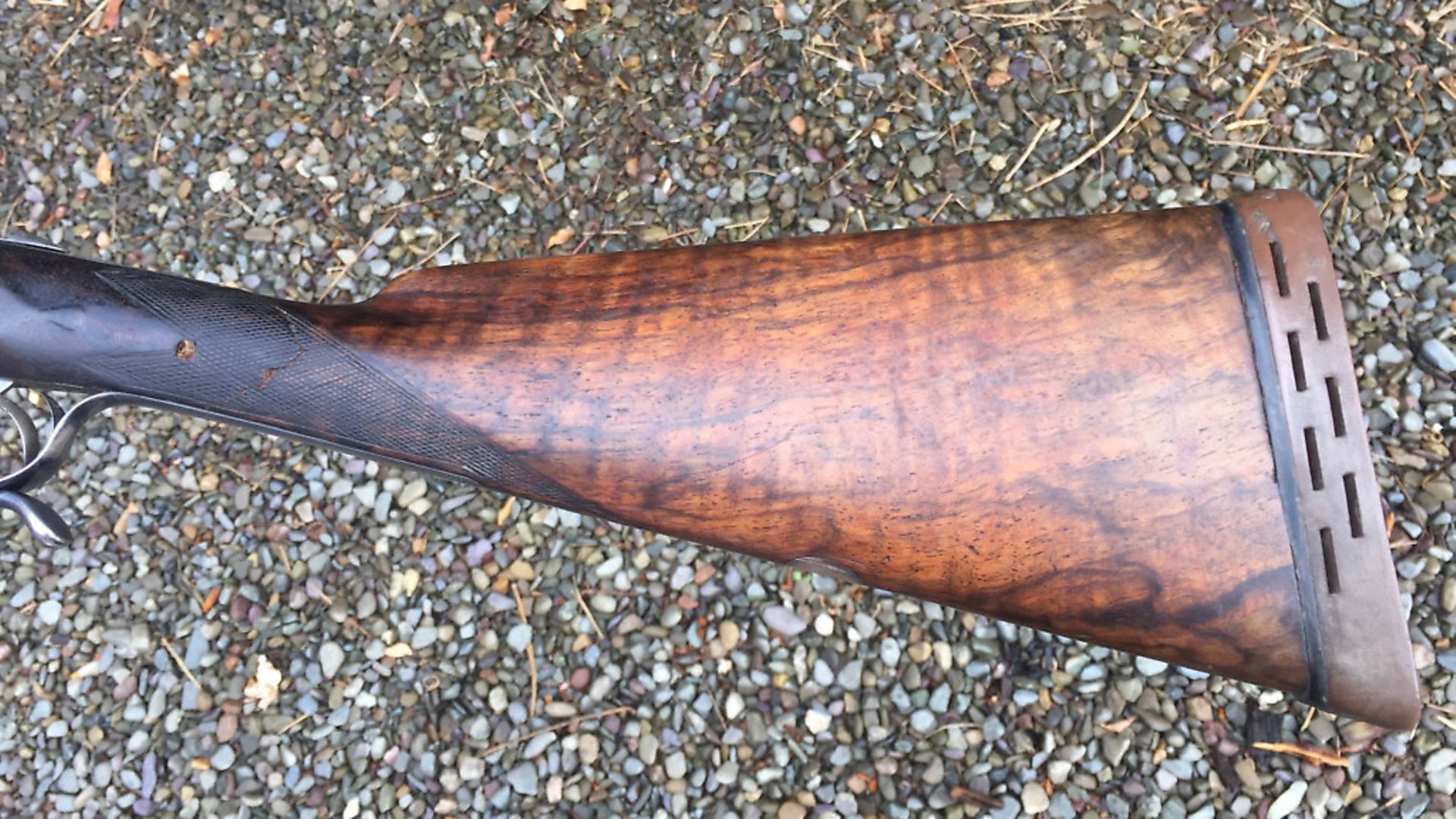How to refinish a wooden stock

Diggory Hadoke lets us in on his tricks of the trade with a recipe for the perfect stock oil, and a step by step guide to refinishing your wooden stock
You should, by now, have read last month’s article on how to prepare your old stock for refinishing. Now, we shall have a look at the process of providing a protective, attractive, traditional finish, using homemade oils.
Before you start, you will need to make your oil. You will need two basic oils: ‘red oil’ and ‘stock oil’.
Stock oils come in all kinds of special recipes. The traditional ‘slacum’ used at Purdey is not the same mixture that was used at Holland & Holland, for example. There are some good commercial versions available, including the CCL product line and Trade Secrets oils, which are widely used in the gun trade. The type of oil you decide to buy or make will depend on the kind of finish you want to achieve. Some produce a satin sheen, others a harder gloss. Modern products, such as Tru-Oil, dry shiny and hard.
I prefer a traditional, ‘soft’ oil finish that sets in the wood, rather than on it. These finishes are far more long-lasting. They age with the gun, weather nicely and can be replenished from time to time without the need for stripping. Harder finishes scratch and chip and soon look nasty and in need of a total refinishing.
I know some finishers who use a mixture, with traditional oils building up a finish and then a few coats of Tru-Oil to provide a glossy end result that won’t be so affected the first time the gun gets taken out in the rain. American clients, in particular, appreciate a high-gloss finish and often complain when the initial shine fades with use, as is the case with a traditional finish.
Since very few gunmakers will share their recipe with you, I’ll share mine. It is based on an old one, but the ingredients need to move with the times, reflecting what is available. The best finish used to be achieved when lead was an ingredient in terabine driers, it has been removed for health and safety reasons and the replacement is not quite as good, lacking that unique sheen that lead imparts into finishes. Still, better than getting cancer.
Stock oil – Put the following into a pan and simmer for 10 minutes, then allow to cool in the pan:
* 16oz boiled linseed oil
* 5 tsp spirit of turpentine* (www.jacksonsart.com)
* 1 tbsp carnauba wax (www.thorne.co.uk)
* 2 tsp Venice turpentine (www.jacksonsart.com)
* Terabine driers can be used instead of spirit of turpentine, if preferred.
Once cool, pour into two bottles. Keep one bottle open and one closed. The open one will become thicker in time, while the sealed one remains liquid. Use either, as and when required.
Before you start with the finishing oil, however, you need to get the colour right and get the figure to look its best. The traditional way to do this is with what gunmakers call ‘red oil’. It is simple to make. All you need are two ingredients: alkanet root in dried form and boiled linseed oil.
You can buy 100g of alkanet root, chopped and dried from www.thesoapkitchen.co.uk for £3.60, and linseed oil is available in most hardware stores. Simply put the dried root in a jar and pour on linseed oil until it is covered, then put the lid on. Leave it, shaking daily, for six months – or longer, if you can. It will become a deep blood red. When it is ready, pour off the oil, leaving the root behind, bottle the oil and you are ready to go.
When your stock is papered up, you will need to raise the grain by wetting your hand and rubbing a light coat of water over the entire stock, then pass the heat gun over it and dry it off. Then rub it lightly with wet and dry sandpaper to remove the fibres that stand up. Do this a few times. Once smooth, leave it to dry properly and then you can start your finish.
Start putting on the red oil with a piece of lint-free cloth. Rub it all over the surface, then leave it. It will be absorbed quite quickly to start with. Keep buffing it off and applying more oil over the next few days. You will see the dark veins in the figure getting darker and the background a deeper, warmer colour. When you are happy with the colour and contrast, you can let it dry for a couple of days, buff it and then you are ready to start with the finishing oil.
Apply finishing oil with a cloth or your hand. Rub it in well, and leave it to semi-dry. When it begins to feel tacky, get a cloth with some more finishing oil on it and use this to ‘rub off’ – that means you are buffing vigorously, in effect forcing the hardened oil into the grain and removing excess from the surface.
Repeat this process for as long as it takes for a finish to begin to show. It depends how absorbent the wood is, but it can take up to six weeks. Do not let an applied-oil coat dry hard; if you do, you will have to cut it back, with wire wool or wet and dry sandpaper, to remove any thick build-up. The trick is lots of very thin coats, building a polish into the wood, which will be beautiful and hard-wearing.
The oil will naturally fill the grain, when you ‘rub off’, so you don’t need a grain sealer. Some people use them, after the ‘red oil’ stage. I prefer not to. It takes longer to finish a stock this way but I think it is a better job. You will know when the grain is filled because the surface will be smooth, without any dips where the grain is open.
Once your finish is complete, leave it to cure for as long as you can. If you can leave it for a couple of months before you use it, it will be more durable. I see a lot of eager shooters take their newly oiled gun out on a rainy pheasant shoot the day after it is finished and express disappointment when it goes hazy.
To maintain the finish, just palm in, and buff off, a tiny bit of finishing oil every now and then, especially if the gun has been out in a lot of rain.






